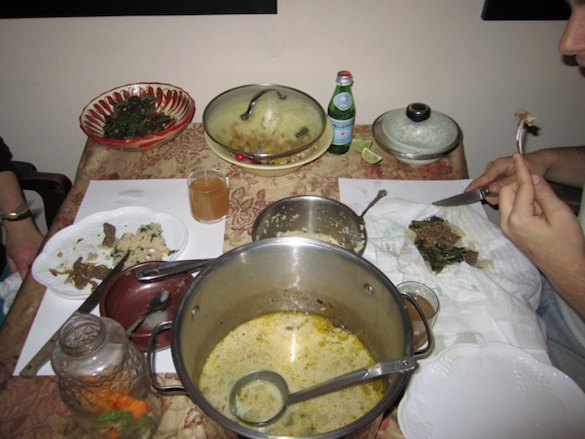A Bitter Melon Meal

Before last week, I had never handled a Bitter Melon.
If you have never encountered one, Bitter Melons are warty, oblong gourd relatives with green, spongy fruit. Most abundantly grown and consumed in tropical areas of Asia, East Africa, and Latin America, Bitter Melons are used for both culinary and medicinal purposes around the world. In the US, bitter melons occupy an "ethnic food" cache, and remain to many an obscure and unappealing vegetable. When I paid for three bitter melons at a grocery store in Chicago's Chinatown last week, I was met by grins from behind the register.
The National Bitter Melon Council, an artist-collective-run organization started in Boston in 2004, capitalizes on these attributes. In their projects, the Bitter Melon becomes prop and propagator for orchestrating food-based interventions and performances. NBMC uses the vegetable to talk about bitterness socially, and broadly. Through collaboration with farm cooperatives, art spaces, and food education initiatives, as well as online and product-based franchising, they promote discussion about that which is unpleasant or rarely acknowledged. As they write in their mission statement: "Advocating the appreciation of this vegetable across cultures and cuisines, the NBMC believes that these Bitter Melon focused-events can bring whole communities together through a single shared experience -- that of bitterness."
In preparation for the National Bitter Melon Council installation for Feast, Andi Sutton, artist and NBMC director of public relations, sent me the following instructions:
Set the table for a dinner for two using the NBMC Place Mat and Napkin.
Prepare a series of dishes using Bitter Melon that make use of every object in the place setting.
Invite someone you don't know very well to eat with you. Eat and talk together.
The installation for Feast will feature NBMC-branded napkins and placemats, including a set used in the dinner that I made last week. As an art student and museum intern, I am used to receiving unconventional requests. But there is something unusually awkward about being asked to express bitterness. In addition to advocating knowledge about an "under-appreciated" vegetable, NBMC seeks to challenge the difficulty of addressing bitterness within the same venues in which we are used to experiencing pleasure -- eating may be the starting place, but the parameters of their mission are not limited to eating experiences. My participation in this meal involved me in a number of ways simultaneously. Though the recipes and impetus for the meal were not my own, as cook and host, I felt responsible for my guest.
Having decided to prepare the Bitter Melons in a few different ways, and uncertain of the results, I became invested in the cooking process. Serving my guest, Michael Bridges, I was surprised by my feelings of apprehension. Was I feeling bitter? Do feelings of bitterness always figure into the roles of hosting and receiving, or of participating in someone else's project?
Meal-based art practices often destabilize or highlight the sensational and social aspects of eating, and over the course of this meal, and my conversation with Michael, my feelings of apprehension were subsumed by a sense of joint enterprise. Both aware that we were performing for each other, the dinner became a meditation on the nature of participation. Through our use, both guided by Andi's instructions and independent of them, the Bitter Melon dishes and NBMC-branded tableware became objects of enjoyment, disgust, abjection, humor, and absurdity.
Recipes prepared for a Bitter Melon dinner on December 5, 2011:
- Bitter Melon Soup with Mango and Shrimp Salsa
- Bitter Melon Beef
- Bitter Melon Cous Cous
- Bitter Melon-Infused Tequila with Ginger Ale and Lime
- Macerated Bitter Melon Sauce with Sorbet and Cookies